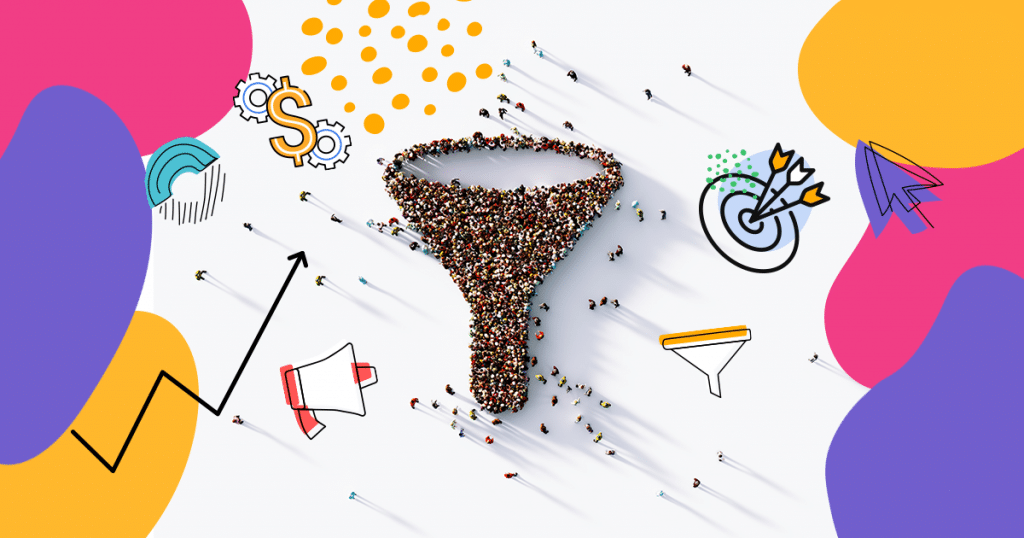There is no doubt that Digital Marketing helps companies by increasing their reach and impacting more consumers daily. However, conversions and sales will only rise if a well-thought-out digital marketing funnel is set in place.
While this concept was initially a tool for sales teams, it has become increasingly critical for marketing teams as well. After all, effective communication and promotion strategies come to life when the right resources are used and directed correctly.
In fact, 570,000 websites are already using at least one marketing funnel-building technology. You don’t to stay behind on that, do you?
Next, let’s uncover what is a digital marketing funnel and how you can create a high-converting funnel for your business or clients. Tag along!
- What Is a Marketing Funnel?
- Traditional Marketing Funnel Vs. Digital Marketing Funnel
- Why Is a Digital Marketing Funnel So Important?
- How to Create an Effective Digital Marketing Funnel
- What is the best type of content for each stage of the funnel
What Is a Marketing Funnel?
A marketing funnel is a visual representation of the journey a customer takes. From learning about your brand to making a purchase, it’s a strategic model that represents the entire buying journey of the personas.
The purpose of this funnel is to help your marketing and sales departments map this journey. Then, they can identify key touchpoints that will enable them to move the customer to the next stage.
This concept is widely used among salespeople but has also become a fundamental resource for the success of marketing actions. Marketing professionals can understand what to offer users at each of the stages within this entire convincing process.
The traditional funnel (created in the late 1900s) consists of four parts:
- Awareness – The customer learns about your business
- Interest – The customer is interested in your products or services
- Desire – The customer wants to buy something from you
- Action – The customer makes a purchase
This AIDA model still works, but with a few tweaks to make it relevant to today’s audience. Many companies will add extra segments like “loyalty” and “advocacy” to their funnels for a more complete customer journey.
Also, each segment can be broken down into separate pieces and touchpoints. It all depends on the specific interactions your marketing and sales teams have with each individual.
The difference between a sales funnel and a marketing funnel
The main difference between a sales and marketing funnel is who interacts with the customer at each point along the journey.
In a marketing funnel, the customer mostly interacts with content and marketing materials. A few examples are blog posts, video clips, e-books, and more.
Once a lead moves through the marketing funnel and into the sales funnel, a salesperson takes over. It’s then time for more personalized interaction. A sales rep can answer questions, provide more materials (i.e., tutorials, pitch decks, etc.), and offer deals or discounts to help close the sale.
So, both funnels work together to convert leads into long-term customers, but it’s also essential that both funnels work in tandem to provide consistent messaging. If there’s a disconnect between what marketing promises and what salespeople deliver, that can lead to dissatisfaction among new customers.
The digital approach to the marketing funnel
There are numerous approaches to the digital marketing funnel concept. The model we will present in this article is divided into six stages:
- exposure
- discovery
- consideration
- conversion
- customer relationship
- retention

With so much competition among companies for the attention and resources of consumers, it’s necessary to prepare and, as a consequence, enhance their communication actions, impacting who matters.
The Digital Marketing funnel will guide all strategies that your company should adopt in search of more conversions.
Traditional Marketing Funnel Vs. Digital Marketing Funnel
A standard marketing funnel is a linear progression from one step to the next. A customer moves along the funnel based on specific interactions.
A digital marketing funnel differs because it focuses on qualifying and segmenting leads into one of the multiple funnels. Each funnel will be centered around a specific type of customer.
It often resembles an hourglass, with multiple pathways branching off in different directions. This process can take longer to complete, but it ensures that the marketing and sales teams are cohesive with their messaging. In fact, there’s a greater likelihood of converting leads into customers.
Overall, a digital marketing funnel aims to reduce churn. Thus, it saves time and resources on leads that have no intention of converting. The more personalized the funnels are, the easier it is for salespeople to close deals and improve the company’s bottom line.
Marketing funnel for B2B
Creating a marketing strategy for a B2B company is challenging because the buyer is another business, not an individual. In most cases, multiple people are involved at various steps within the funnel, so both the marketing and sales departments have to appeal to a diverse range of personalities and needs.
Typically, the person who expresses interest in the product is not the one making the final purchase decision, so a B2B marketing funnel needs to address that discrepancy.
Realistically, an effective B2B marketing funnel will accommodate touchpoints with different members of the client’s business, such as the CEO, department manager, supervisors, accountants, and more.
By incorporating these people into the funnel from the beginning, it’s easier for the marketing team to create materials that appeal to everyone involved, not just the initial point of contact.
Marketing funnel for B2C
The AIDA version of a marketing funnel is designed with the customer in mind, so it works perfectly for B2C sales. Since the individual is both the point of contact and the decision maker, marketers only have to appeal to one person, not multiple people within a larger organization.
For this reason, it’s best to create unique marketing funnels for specific demographics or user identities. This way, the marketing and sales teams can ensure they’re both working from the same outline and addressing the same concerns to move the lead through the funnel.
So, instead of building a network of different pathways for each segment, it’s better to just create a separate funnel altogether.
Click Funnel Marketing
With a traditional marketing funnel, a lead will interact with different pieces of content across various channels before deciding to contact your business.
With a click funnel, the process is much faster and more streamlined. Instead of having multiple interactions across different periods, a lead will click through the funnel until they’re ready to contact a salesperson.
An example of a click funnel may be similar to this:
- Ad – A user sees an ad, such as on social media or through a search engine.
- Landing Page – After clicking on the ad, the user reaches a landing page that offers more information about the product or service. A user may click through multiple landing pages, but they will all lead to the same place – a conversion page.
- Call to Action – The user will see a specific call to action, such as subscribing to a list or going to a product listing. From there, the user can either decide to make a purchase or contact a salesperson to move on to the next step.
Content Marketing Funnel
As we mentioned, a marketing funnel mostly deals with interactions between leads and content designed to spark their interest in your product or service.
So, a content marketing funnel embraces this process by developing specific content pieces for the different segments of the funnel. If a segment refers to social media channels, your marketing team can create content to share across these platforms.
Similarly, if a segment involves blog posts, the marketing team can craft unique articles to address specific needs or concerns that the customer may have at that point in the funnel.
Content marketing is more labor-intensive, but if you use a service like WriterAccess, you can connect with world-class writers from all industries who can craft unique pieces that will help convert leads into customers.
Claim your free two-week trial now and see how WriterAccess can improve your next marketing funnel.
Why Is a Digital Marketing Funnel So Important?
In practice, why is the funnel concept so crucial in any Digital Marketing strategy?
The first and primary benefit is precisely to perform a better segmentation of your marketing actions, directing content, ads, and other strategies with messages that will be useful for your audiences throughout the buyer’s journey.
As a consequence, lead generation work also becomes more efficient, delivering more qualified leads to your sales team, and making the conversion challenge easier.
When the funnel is approached correctly, you get closer and closer to the consumers, always being relevant in their journey.
Also, the productivity of your entire team tends to increase, once professionals dedicate themselves to, for example, producing the right content at the right time, without wasting time and resources on actions that aren’t effective.
Since the main advantage of digital advertising is precisely the segmentation of your communication actions, you will be able to talk to the right audience and, of course, offer the most appropriate content for each stage.
What’s the point of creating an ebook on a certain subject if your public is not yet prepared for it? What’s the point of impacting users who don’t understand they have a problem to solve with more advanced content? You need to be more precise in your actions.
This would represent a waste of time and resources for your company. The Digital Marketing funnel serves to guide all these actions, following each step to deliver the most accurate content.
As important as it is to respect the user’s time to leave each stage of the funnel, having this broader view of the consumer’s journey allows you to urge them to move from one stage to another.
In short, the Digital Marketing funnel is crucial to make better use of your company’s resources and improve your bottom line.
How to Create an Effective Digital Marketing Funnel
Even though it’s so crucial to the success of your Digital Marketing strategy, not everyone knows what needs to be done to create a funnel for your business.
The first step is simple: create a goal for your actions — it may be to sell more or increase the Return On Investment (ROI) of your business. In short, a goal to be achieved.
Then you need to structure the funnel, defining the steps that are part of the sales cycle.
By creating a visual image of the stages, it’s easier to know precisely what is the best model for your business.
With your funnel established, it’s time to understand what you need to do to generate the expected traffic in each stage.
In this way, your target audience will be impacted by material that is aligned with their level of knowledge.
What is the best type of content for each stage of the funnel
Understanding how the Digital Marketing funnel works will ensure that your actions are more accurate, making better use of your company’s available resources and impacting users who may become consumers of your brand.
That’s why we separated the best type of content for each stage. Check it out!
Exposure
No matter which Digital Marketing funnel is established for your business, it should start with the exposure step.
After all, nothing will work if the consumer doesn’t know your company. What better way to do this than by advertising and promoting your brand on the right platforms?
On average, there are about 75,000 searches per second on Google. In other words, you need to be present and, more importantly, be seen within this channel.
Therefore, the idea is to start your Content Marketing strategy by strengthening your presence with Search Engine Optimization (SEO) techniques or even paid advertisements in search engines.
The important thing is that the user enters a specific keyword, and your page appears among the main results.
At this stage, the goal is to produce content that captures the attention of users, such as educational videos and infographics. Now it’s time to attract as much traffic as possible.
On your blog, focus on those materials directed to people who don’t know your company or the fact that you can offer the solution to some of their problems.
The formula for this step is simple: to increase exposure, the company should work with subjects that attract a high number of people and are related to her.
To do it, they can do research focusing on a head-tail keyword, with thousands of searches per month.
Discovery
In this next step, it is ideal for focusing on producing content that encourages users to take an interest in your brand.
After all, as much as the previous stage means that they already know your company, it is necessary to make them stay on your page to discover your products, services, and solutions.
There is no point in taking a user to your website if they have no interest in your brand. This will only serve to increase the bounce rate of your site, which can even harm the stage of exposure.
The main goal of this stage is to turn the visitor into a lead.
And now the first challenge arises: to offer some material or content that encourages the user to leave contact information, for example.
The most suitable suggestion for this stage is to deliver rich and educational content that presents a problem and offers a solution.
Consideration
The consumers are at a stage of consideration when they know your brand, and that they have a problem your company can solve.
It is up to you, then, to deliver materials that facilitate their decision process. Therefore, the most suitable materials are the ones that explain your company’s differentials and benefits.
At this stage, you already know a little more about the leads and exactly what they are looking for.
Your content must present facts and information that prove the efficiency of your solution.
Present Frequently Asked Questions (FAQ) that solve their main issues or relevant evaluations from other customers.
After all, there is nothing better than the opinion of those who have already tried a certain product or service to make their decision.
Investing in case studies, for example, is an excellent way to clear up any doubts they have regarding what you offer.
The idea is to deliver everything that serves to confirm the efficiency of your work.
Conversion
Now that you have shown the pros and cons of your offer, it’s time to help them to make the decision. After all, you want loyal customers.
So, it’s time to focus on more and more personalized content according to your goals, preferences, and challenges. It’s time to create customized campaigns.
With sponsored links, you can draw the user’s attention to a specific landing page, focused almost exclusively on its conversion.
A hint of content for these pages is the free trials, letting the user experience your product or service for a while and know even more about its advantages and benefits.
In all communications, it is necessary to focus on the results that the user will be able to obtain with your company’s help, leaving a little of the functionalities aside.
The idea is that he understands, in practice, how what you offer is better than what you offer in the competition.
Customer relationship
With the lead conversion established, the next step is to get closer to your customers.
It’s increasingly essential to leave advertisements for your brand aside and focus on teaching the client how to use your solution to solve their problems. This closer contact can become a competitive advantage.
Investing in a drip campaign to further educate the customer and clarify their main questions is an excellent alternative.
Being able to show that you aren’t just interested in getting a conversion but want to help the consumer solve their problems and make their business prosper.
You can invest your resources in an email marketing strategy, strengthening your ties with the lead even more.
This way, you can establish a direct channel with them and always be at their disposal to solve their doubts. Now that they know your company and how you can help them, it’s time to stand out from the competition.
Another option is using videos with tutorials to help the consumer use your products and services, showing that you care about their performance.
Also, exclusive content to present a product release, for example, is incredibly efficient to get even closer to whoever is on the other side.
Retention
The work has been long, but it is not over yet. It’s time to think about the actions and content focused on the retention challenge.
In other words, make the consumer who already knows your brand and has bought your product or service continue to make new transactions. Especially in the long term, this stage is fundamental.
In addition to continuing the production of content from the previous stage, it’s essential to monitor and analyze your communications with the lead regularly.
A very efficient way to do that is to interview the client to create a case study to be used in the previous stages.
Creating a Digital Marketing funnel for your business is, therefore, fundamental to developing increasingly accurate actions and generating an impact on your buyer persona.
With so many benefits of disseminating and promoting your brand digitally, it’s necessary to know and apply all the concepts required to take advantage of the resources properly.
Now you know the importance of this concept, and how to create a Digital Marketing funnel for your business. It’s time to strengthen your funnel by scaling your content production with WriterAccess, a marketing professional’s marketplace for all your needs.










